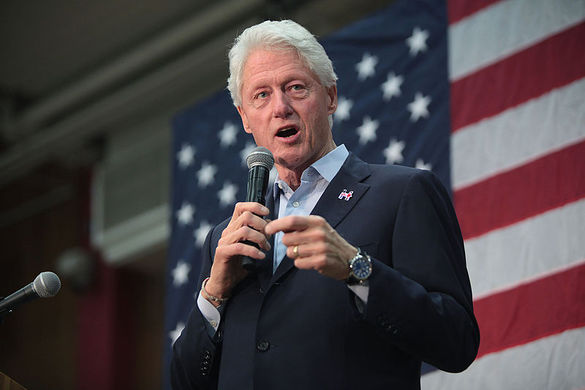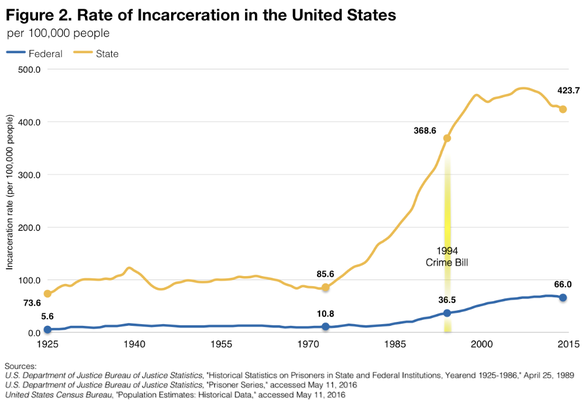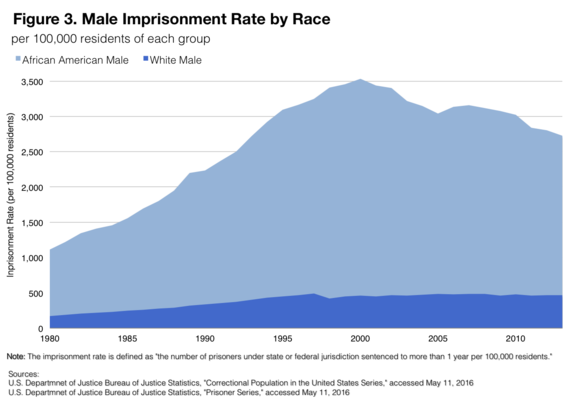Fact check: Was the 1994 crime bill a primary driver of mass incarceration of African American men?

At a campaign event for Hillary Clinton in Philadelphia last month, former President Bill Clinton was interrupted by Black Lives Matter (BLM) activists criticizing the 1994 Violent Crime Control and Law Enforcement Act—which, among other things, established longer mandatory sentences, eliminated federal funding for inmate education, and put 100,000 more police officers on the street.[1][2]
The 1994 crime bill has become a top talking point in the 2016 Democratic primary race, as both Hillary Clinton and Sen. Bernie Sanders have built criminal justice reform platforms aimed at reversing the “tough-on-crime” approach of the 1994 bill.[3]
And on the campaign trail, both Bill and Hillary Clinton have faced criticism from BLM activists over the law, with many claiming that the act ushered in an era of mass incarceration that has disproportionately affected African American men.[4][5] For instance, in a 2015 interview with MSNBC, Black Lives Matter activist Julius Jones claimed that "the policy mistakes that [Hillary Clinton] and the Clintons made got us, in large degree, to the situation that we are in today with mass incarceration."[6]
So, was the 1994 crime bill a key driver of the mass incarceration of African American men? While the act did contain several “tough-on-crime” measures, the rise in federal and state prison populations—both in total and for African American males—was already underway by 1994.
The Violent Crime Control and Law Enforcement Act of 1994
According to Federal Bureau of Investigation (FBI) data, the national violent crime rate—the number of violent crimes per 100,000 population—increased by an estimated 56 percent from 1976 through 1990. In 1991—three years before President Clinton took office for a second term—the violent crime rate peaked at over 758 per 100,000 residents (see Figure 1).[7][8][9]

At the time, crime was a top issue for voters. In 1994, public opinion polls showed that 37 percent of Americans (a plurality) said crime was the “most important problem facing the country”—ranking above 22 other issues including healthcare (20 percent), unemployment (18 percent), and the economy (14 percent).[10]
Taken together, the trend in crime rates and public opinion helped foster receptiveness to political appeals for a "tough-on-crime" agenda.
On August 25, 1994, after extended negotiations between Republicans and Democrats in Congress, as well as within both parties, the Senate voted 61 to 38 in favor of the 1994 Crime Bill—six Republicans joined 55 Democrats in voting "yes."[11] Four days earlier, the bill passed by a vote of 235 to 195 in the House, with 46 Republicans and one independent voting in favor.[12]
The $30.2 billion dollar anti-crime package, which Bill Clinton signed into law on September 13 of that year, authorized roughly $7 billion for crime prevention programs, $9.7 billion in funding for new prisons, and $13.4 billion for local, state, and federal law enforcement.[2][13]
Among other measures, the law established a "three strikes" provision, which mandated sentences ranging from 25 years to life for many repeat offenders, expanded federal mandatory minimum sentences, and required states (as a condition of obtaining federal funds for prison construction) to adopt truth-in-sentencing (TIS) laws, "which require that persons convicted of violent crimes serve not less than 85 percent of the sentence imposed."[2] These measures, some claim, pushed the nation's combined federal and state prison population to its peak of 1.6 million in 2009.[14]
1994 crime bill and mass incarceration
According to data from the Bureau of Justice Statistics (BJS), the national incarceration rate—the number of persons incarcerated per 100,000 population—began a sustained period of growth in 1973—20 years before Clinton signed the 1994 crime bill (see Figure 2). In absolute numbers, the federal and state prison populations increased fivefold between 1973 and 1994 (from 204,201 to 1,054,702 total prisoners).[15][16]

The composition of the prison population has also changed during this time period. In 1964, 33 percent of all those sentenced under state or federal jurisdiction were African American. By 1994, this percentage climbed to 51.1 percent—and 46.7 percent were African American men.[17][18] Furthermore, while the imprisonment rates of both white and black males have risen since 1980, the rate for African American males has grown more rapidly (see Figure 3).[19] Between 1980 and 1994, the black, non-Hispanic male imprisonment rate grew by 163 percent (from 1,111 per 100,000 U.S. black male residents to 2,932). The imprisonment rate for white males increased by 157 percent over the same time period (from 168 per 100,000 U.S. white male residents to 432). In 1994, African American men were roughly 6.8 times as likely as white males to be incarcerated in federal and state prisons.[20][21]

While most of the act’s provisions applied only to federal crimes, the major increase in incarceration numbers occurred at the state level (see Figure 2). Granted, there were some provisions of the bill aimed at influencing state law, such as the Truth-in-Sentencing (TIS) Incentive Grant Program, which set aside $9.7 billion for states that enacted truth-in-sentencing laws to build and operate prisons. However, according to a General Accounting Office study, only four states—Louisiana, Maine, New York, and Oklahoma—said that the 1994 truth-in-sentencing grants were “a key factor” in their decisions to enact TIS laws. Twelve of the 27 grant recipient states said the grants were “not a factor," and 11 states said the grants were a “partial factor,” citing instead their separately enacted “get-tough-on-crime initiatives” as the primary influence in the passage of TIS legislation.[22]
Furthermore, some states adopted TIS laws before the 1994 Crime Bill, said Bernadette Rabuy, a senior policy analyst at the Prison Policy Initiative, a nonpartisan research group that supports reducing the prison population.[23]
"It's a stretch to say the 1994 bill was a primary cause [of mass incarceration]," stated Rabuy; instead, the bill "was probably most harmful for its rhetoric [...] and the cultural impact. After the 1994 bill, being tough on crime was a truly bipartisan effort."[23]
So if the 1994 crime bill did not cause mass incarceration, the question becomes: What did influence the increase in prison populations?
1980s war on drugs legislation
The rise in incarceration was driven, at least in part, by the U.S. war on drugs, which gave rise to state laws (like the 1973 New York Rockefeller drug laws, a set of mandatory sentencing statutes for drug crimes) and federal drug control legislation (such as the Comprehensive Crime Control Act of 1984, the Anti-Drug Abuse Act of 1986, and the Anti-Drug Abuse Act of 1988).[24]
In response to the sharp rise of violent crime and drug prevalence, these laws, among other things, standardized federal sentencing procedures, increased the penalties for federal drug offenses, and established mandatory minimum prison terms, with sentences based on the type and quantity of the drug involved. The possession of five grams of crack cocaine (or “cocaine base”) now carried the same sentence as possession of 500 grams of powder cocaine.[25][26][27][28][29]
This crack cocaine sentencing policy has had a disproportionate impact on African Americans. In 1995, 88.4 percent of those convicted of federal crack offenses were African American.[30] And while the ratio was reduced in 2010 (from 100-to-one to 18-to-one), the sentencing gap remains—in 2015, 79.9 percent of persons prosecuted in the federal system for crack offenses were African American.[31][32]
Additionally, a large portion of the growth in state and federal imprisonment is due to the increased number of arrests for drug offenses. According to FBI Uniform Crime data, between 1965 and 1992, the arrest rate for drug abuse violations increased from roughly 36 per 100,000 adults to 555 per 100,000.[33] And while the arrest rate of both white and black adults for drug violations has risen since 1970, the rate for black people has grown more rapidly. In 1970, black adults were roughly three times as likely to be arrested for drug violations than white adults; by 1992, this rate climbed to five times that, with 2,000 per 100,000 black adults arrested for drug violations.[34]
Conclusion
In recent months, both Bill and Hillary Clinton have faced criticism from Black Lives Matter activists over the 1994 Violent Crime Control and Law Enforcement Act, with many claiming that the bill ushered in an era of mass incarceration of African American men.[1][2]
While the bill did contain several “tough-on-crime” measures—such as expanding mandatory minimum sentences and establishing a federal “three-strikes” law—the rise in federal and state prison populations—both in total and for African American males—was already underway more than 20 years before President Clinton signed the bill.
See also
Launched in October 2015 and active through October 2018, Fact Check by Ballotpedia examined claims made by elected officials, political appointees, and political candidates at the federal, state, and local levels. We evaluated claims made by politicians of all backgrounds and affiliations, subjecting them to the same objective and neutral examination process. As of 2025, Ballotpedia staff periodically review these articles to revaluate and reaffirm our conclusions. Please email us with questions, comments, or concerns about these articles. To learn more about fact-checking, click here.
Sources and Notes
- ↑ 1.0 1.1 New York Times, "Bill Clinton, Heckled by ‘Black Lives’ Protesters, Defends Record on Crime," April 7, 2016
- ↑ 2.0 2.1 2.2 2.3 Government Printing Office, "H.R. 3355: Violent Crime Control and Law Enforcement Act of 1994," accessed May 5, 2016
- ↑ The Washington Post, "Transcript: The Democratic debate in Milwaukee, annotated," February 11, 2015
- ↑ In 2014, 37 percent of the 1.5 million state and federal prison population were African Americans, while African Americans made up only 13.2 percent of the entire U.S. population. See: United States Census Bureau, "QuickFacts: United States," accessed May 11, 2016 and U.S. Department of Justice Bureau of Justice Statistics, "Prisoners in 2014," September 2015
- ↑ NPR, "In South Carolina, Young Black Voters Could Put Holes in Clinton’s Firewall," February 11, 2016
- ↑ MSNBC, "Exclusive: When Hillary Clinton met Black Lives Matter," August 17, 2015
- ↑ The violent crime figures include the offenses of murder, rape (legacy definition), robbery, and aggravated assault.
- ↑ Federal Bureau of Investigation, "Uniform Crime Reports - Table 1: Crime in the United States," accessed May 11, 2016
- ↑ Federal Bureau of Investigation, "Crime in the United States, 1995 - Section II: Crime Index Offenses Reported," accessed May 11, 2016
- ↑ University at Albany, "Sourcebook of criminal justice statistics," 2012
- ↑ United States Senate, "U.S. Senate Roll Call Votes 103rd Congress - 2nd Session: Vote No. 295," August 25, 1994
- ↑ Office of the Clerk – U.S. House of Representatives, "Final Vote Results for Roll Call 416," August 21, 1994
- ↑ New York Times, "The Crime Bill: Overview; House Approves Crime Bill After Days of Bargaining, Giving Victory to Clinton," August 22, 1994
- ↑ Brennan Center for Justice, "The Complex History of the Controversial 1994 Crime Bill," April 14, 2016
- ↑ U.S. Department of Justice Bureau of Justice Statistics, "Historical Statistics on Prisoners in State and Federal Institutions, Yearend 1925-1986," April 25, 1989
- ↑ U.S. Department of Justice Bureau of Justice Statistics, "Prisoners in 2014," September 2015
- ↑ U.S. Department of Justice Bureau of Justice Statistics, "Race of Prisoners Admitted to State and Federal Institutions," May 1991
- ↑ U.S. Department of Justice Bureau of Justice Statistics, "Prisoners in 1996," June 1997
- ↑ The imprisonment rate is defined as "the number of prisoners under state or federal jurisdiction sentenced to more than one year per 100,000 residents." For more information about the methodology used in calculating the imprisonment rate, see: U.S. Department of Justice Bureau of Justice Statistics, "Prisoners in 2010," February 9, 2012
- ↑ U.S. Department of Justice Bureau of Justice Statistics, "Correctional Populations in the United States, 1992," January 1995
- ↑ U.S. Department of Justice Bureau of Justice Statistics, "Correctional Populations in the United States, 1997," November 2000
- ↑ United States General Accounting Office, "Truth in Sentencing: Availability of Federal Grants Influence Laws in Some States," February 1998
- ↑ 23.0 23.1 Autumn Lewien, "Email conversation with Bernadette Rabuy," May 4, 2016
- ↑ New York State Division of Criminal Justice Service, "Drug Law Changes," accessed May 11, 2016
- ↑ Monitoring the Future, "National Survey Results on Drug Use 1975-2011," June 2012
- ↑ Congress.gov, "S.1762 - Comprehensive Crime Control Act of 1984," accessed May 6, 2016
- ↑ Government Printing Office, "H.R. 5484: Anti-Drug Abuse Act of 1986," October 27, 1986
- ↑ Government Printing Office, "H.R. 5210: Anti-Drug Abuse Act of 1988," November 18, 1988
- ↑ United States Sentencing Commission, "Report on Cocaine and Federal Sentencing Policy: Chapter 6," accessed May 4, 2016
- ↑ United States Sentencing Commission, "Sourcebook 1995 - Table 38: Race of Drug Defendant by Drug Type: (October 1, 1994 through September 30, 1995)," accessed May 11, 2016
- ↑ Government Printing Office, "Fair Sentencing Act of 2010," August 3, 2010
- ↑ United States Sentencing Commission, "Sourcebook 2015 - Table 34: Race of Drug Offenders in Each Drug Type: Fiscal Year 2015," accessed May 11, 2016
- ↑ A race-specific arrest rate is defined as "the number of arrests made per 100,000 inhabitants belonging to a prescribed race." See: U.S. Department of Justice Federal Bureau of Investigation, "Uniform Crime Reports: Age-Specific Arrest Rates and Race-Specific Arrest Rates for Selected Offenses 1965-1992," December 1993
- ↑ U.S. Department of Justice Federal Bureau of Investigation, "Uniform Crime Reports: Age-Specific Arrest Rates and Race-Specific Arrest Rates for Selected Offenses 1965-1992," December 1993
Contact
More from Fact Check by Ballotpedia
May 12, 2016
| Did congressional candidate Schwartz lead the "charge on the war on coal" as a state senator? May 6, 2016 |
| Did Sen. Ayotte vote for cuts to Pell Grants and against refinancing student loans? May 3, 2016 |
Follow us on Facebook and Twitter







